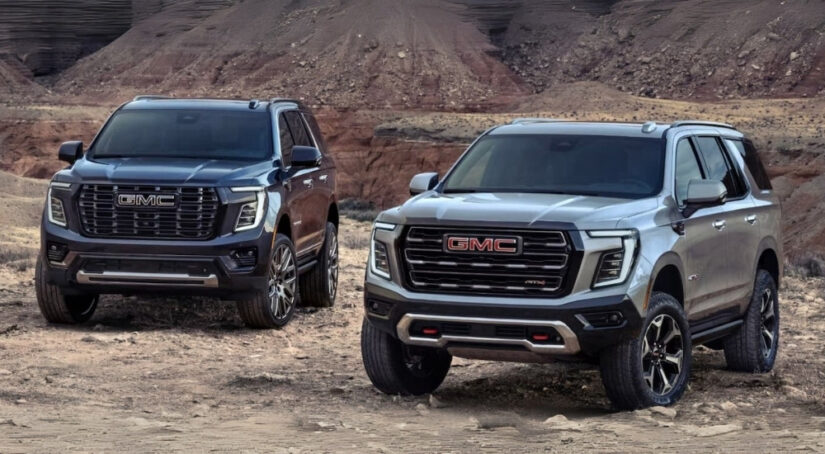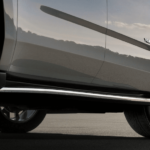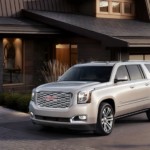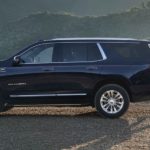There are many reasons why drivers choose SUVs, with the great space they offer for both passengers and cargo being one of the key ones. If this reason tops your list, too, you might wonder how some of the leading SUVs measure up, including two from a brand with more than a hundred years of experience on its side: the GMC Yukon and Yukon XL.
Both of these SUVs share a number of amenities, but they also differ in a few ways, including the fact that the Yukon XL is approximately 15 inches longer. However, do you truly need that much more space, and what other differences might tip the scales one way or another? The answers to these questions and more can be found below, ensuring you have all the details you need before heading to your local GMC dealer for a test drive.
How Size Matters
As mentioned, one of the many reasons why drivers choose an SUV is the ability to haul more passengers and cargo than what is possible with other types of vehicles. When choosing the Yukon or Yukon XL, you will gain a maximum seating capacity of eight, or you can get a capacity for seven people with second-row bucket seats reminiscent of the same ones in the front row.
This might make you question where the extra 15 inches come in. While the capacity for passengers doesn’t increase between the two models, the extra inches grow the room that each passenger has, along with added cargo space. Breaking down the numbers, you will find that the overall vehicle length for the Yukon is 210.1 inches, while the Yukon XL is 225.2 inches long. Regarding legroom, particularly in the third row, the Yukon XL gives passengers 1.8 inches more space.
Beyond more legroom, the Yukon XL offers significantly more cargo space both behind every row and in general. With all seats in place, the Yukon offers 25.5 cu.ft. behind the third row. Folding down that row yields 72.5 cu.ft., and folding the second row as well gives you 122.9 cu.ft. By comparison, the Yukon XL delivers 41.5 cu.ft. behind its third row, 93.6 cu.ft. behind its second row, and a staggering 144.5 cu.ft. of total cargo space with both rear rows folded down, which, if you’re doing the math, is over 20% more than the classic Yukon.
In practical terms, the Yukon XL can haul a ton of gear, whether it’s luggage for a road trip, camping equipment, golf bags, or more, even with the third row in use. Ultimately, while the seating capacity doesn’t differ, the room your passengers have and the total cargo space do, which might make the Yukon XL the better choice for you if size truly matters. Otherwise, the classic Yukon’s still-generous dimensions make it easier to maneuver while offering a very spacious cabin on its own.
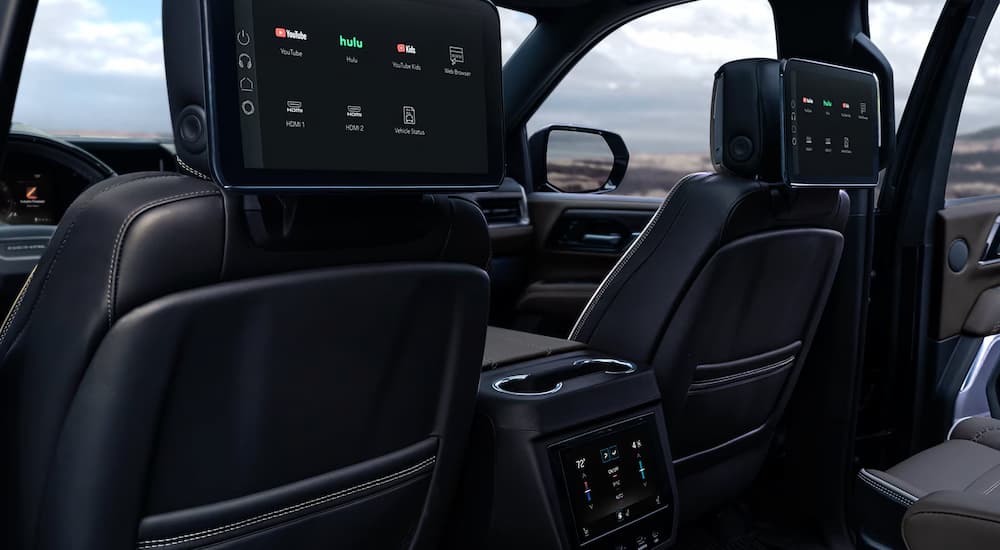
Cabin Comfort
Both the Yukon and Yukon XL have three rows of seating with flexible configurations. The standard setup in most trims is a 2‑3‑3 layout, with front bucket seats, a second-row bench, and a third-row bench, giving you room for eight passengers. However, you can choose second-row captain’s chairs when opting for a higher trim, which decreases the capacity to seven. This also provides better access to the third row.
Passengers in all three rows enjoy a roomy environment. Front-row and second-row legroom and headroom are essentially identical between the two models, with 42.3 inches of front headroom and 44.5 inches of legroom. As mentioned, it’s the third row where the changes start to take shape. While the Yukon offers 34.9 inches of third-row legroom, the Yukon XL gives you 36.7 inches, which is key for longer trips, particularly if your third-row passengers are teens or adults. Both models offer ample shoulder and hip room, with the former being 64.8 inches and the latter measuring 61.3 inches for the second row, for instance.
The interiors of both SUVs are built with comfort in mind. Higher trims have things like premium cushioned seating and upholstery, as well as real wood accents on the dashboard and doors, while most models come standard with heated, power-adjustable front seats and a heated steering wheel.
Connectivity Tech
GMC packed the 2025 Yukon and Yukon XL with much of the latest technology you would expect, such as a 16.8-inch touchscreen infotainment display mounted in a portrait orientation. This high-resolution screen offers customizable layouts for navigation, audio, apps, and vehicle information. Along with this, an 11-inch digital instrument cluster sits just beyond the steering wheel.
The brand offers wireless Apple CarPlay and Android Auto for smartphone integration, a Wi-Fi hotspot, and available Google Built-In for additional support. You’ll also find a wireless charging pad and multiple USB-C ports throughout the cabin. Another standout available feature is Super Cruise, GM’s hands-free driving tool. When equipped, Super Cruise lets you drive hands-free on compatible highways, reaching your destination relaxed and ready to go. This tool even includes a trailering mode, letting you tow while it’s engaged.
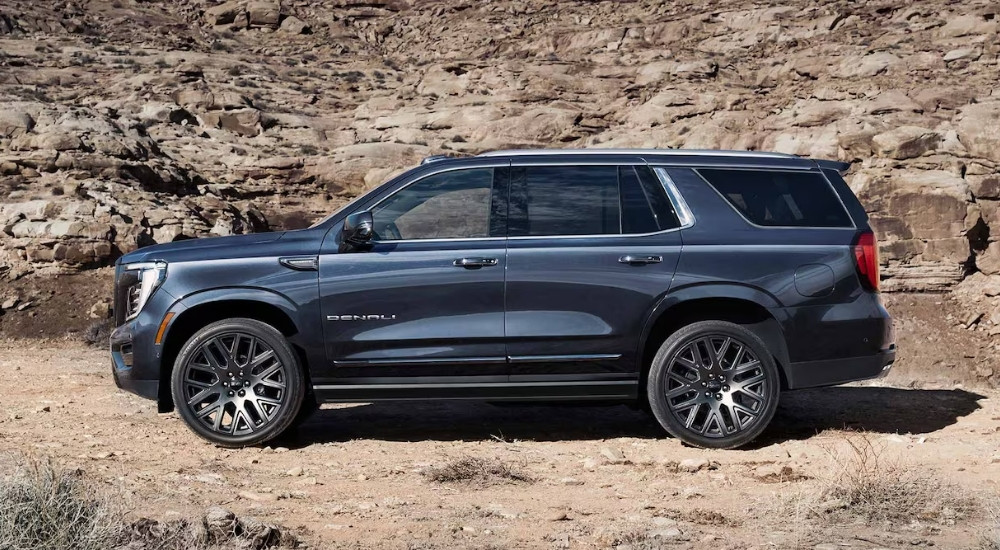
Power and Prowess
Under the hood, the Yukon and Yukon XL share identical powertrain choices. The base engine is a 5.3L V8, which provides you with 355 hp, while upper trims can be found with a 6.2L V8, delivering 420 hp and 460 lb-ft of torque. Additionally, if you’re looking for a diesel option, you can find a Yukon or Yukon XL with a 3.0L Duramax Turbo-Diesel I-6 that provides 305 hp and 495 lb-ft of torque. All engines are paired with a 10-speed automatic transmission, and most trims have rear-wheel drive standard, or you can upgrade to all-wheel drive.
Regarding towing, both models have a capacity of up to 8,400 lbs of towing when properly equipped with the 5.3L V8 and Trailering Package. This figure is highly competitive among full-size SUVs. Perhaps even more compelling is the towing technology available, such as Transparent Trailer View (which is a virtual “see-through” view behind your trailer) and Trailer Reverse Steering Guidance. Additionally, standard towing aids include trailer tire pressure and tire health monitoring, Blind Zone Steering Assist (which accounts for the length of your trailer), and Jack-Knife Alert. All these work whether you’re towing a boat, camper, or horse trailer.
Which Size SUV Is Right for You?
If you need maximum space, the Yukon XL is the obvious choice. Its longer frame means you can fit eight people better and still have plenty of cargo space in the rear. This is ideal for big families, groups of friends, or anyone hauling bulky cargo. On the other hand, if you mostly drive in the city or suburbs or rarely carry a full load of people, the classic Yukon is still very roomy and is easier to park and maneuver, as it has a slightly tighter turning radius and shorter overhang than the Yukon XL.
The classic Yukon also weighs slightly less than the Yukon XL, so it may feel a bit more nimble on the road. Other considerations, such as towing, power, and technology, are all about the same, meaning you won’t “lose” anything by going with the Yukon over the Yukon XL. Regardless of your choice, both the Yukon and Yukon XL offer a bold new design, the latest tech, and a comfortable ride. Ultimately, you really can’t go wrong; your Yukon preference is simply a matter of how much space you need.
